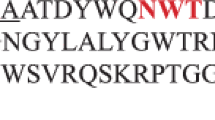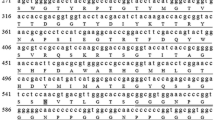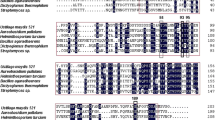Abstract
A full-length cDNA sequence of Aoxyn11A, a mesophilic xylanase-encoding gene from Aspergillus oryzae, was obtained from total RNA, using 3′ and 5′ rapid amplification of cDNA ends methods. The cDNA sequence is 1,086 base pairs in length, containing 5′-untranslated and 3′-untranslated regions and an open reading frame encoding a 20 amino acid (aa) signal peptide, a 24 aa propeptide and a 188 aa mature peptide (designated AoXyn11A). Multiple alignments verified that AoXyn11A belongs to glycoside hydrolase family 11. Its three-dimensional structure was predicted by multiple templates–based homology modeling. In addition, an AoXyn11A-encoding cDNA gene was extracellularly expressed in Pichia pastoris GS115, mediated by the modified pPIC9K vector. One P. pastoris transformant, numbered as GSAorX4-3 and having the highest recombinant AoXyn11A (reAoXyn11A) activity of 98.0 U/ml, was chosen. The reAoXyn11A showed maximum activity at pH 5.5 and 50 °C. It was highly stable at a pH range of 4.0–8.0 and at 40 °C. Its activity was not significantly affected by metal ions that were tested or EDTA, but was strongly inhibited by Mn2+ and Ag+. The K m and V max of the reAoXyn11A were 1.85 mg/ml and 3,018 U/mg, respectively.








Similar content being viewed by others
References
Asha PC, Prema P (2007) Production of cellulase-free endoxylanase from novel alkalophilic thermotolerent Bacillus pumilus by solid-state fermentation and its application in wastepaper recycling. Bioresour Technol 98:85–490
Cantarel BL, Coutinho PM, Rancurel C, Bernard T, Lombard V, Henrissat B (2009) The carbohydrate-active enzymes database (CAZy): an expert resource for glycogenomics. Nucleic Acids Res 37:D233–D238
Chen XL, Cao YH, Ding YH, Lu WQ, Li DF (2007) Cloning, functional expression and characterization of Aspergillus sulphureus β-mannanase in Pichia pastoris. J Biotechnol 128:452–461
Collins T, Gerday C, Feller G (2005) Xylanases, xylanase families and extremophilic xylanases. FEMS Microbiol Rev 29:3–23
Dubois M, Gilles KA, Hamilton JK, Rebers PA, Smith F (1956) Colorimetric Method for Determination of Sugars and Related Substances. Anal Chem 28:350–356
Dumon C, Varvak A, Wall MA, Flint JE, Lewis RJ, Lakey JH, Morland C, Luginbühl P, Healey S, Todaro T, DeSantis G, Sun M, Parra-Gessert L, Tan X, Weiner DP, Gilbert HJ (2008) Engineering hyperthermostability into a GH11 xylanase is mediated by subtle changes to protein structure. J Biol Chem 283:22557–22564
Eswar N, Eramian D, Webb B, Shen MY, Sali A (2008) Protein structure modeling with MODELLER. Methods Mol Biol 426:145–159
Fawzi EM (2010) Highly thermostable purified xylanase from Rhizomucor miehei NRRL 3169. Ann Microbiol 60:363–368
Fuzi SFZM, Mahadi NM, Jahim JM, Murad AMA, Bakar FDA, Jusoh M, Rahman RA, Illias RM (2012) Development and validation of a medium for recombinant endo-β-1,4-xylanase production by Kluyveromyces lactis using a statistical experimental design. Ann Microbiol 62:283–292
Khandeparker R, Numan MT (2008) Bifunctional xylanases and their potential use in biotechnology. J Ind Microbiol Biotechnol 35:635–644
Laemmli UK (1970) Cleavage of structural proteins during the assembly of the head of bacteriophage T4. Nature 227:680–685
Li JF, Tang CD, Shi HL, Wu MC (2011) Cloning and optimized expression of a neutral endoglucanase gene (ncel5A) from Volvariella volvacea WX32 in Pichia pastoris. J Biosci Bioeng 111:537–540
Liu MQ, Liu GF (2008) Expression of recombinant Bacillus licheniformis xylanase A in Pichia pastoris and xylooligosaccharides released from xylans by it. Protein Expr Purif 57:101–107
Liu Y, Su C, Song XS, Tan YL, Bao ZH (2009) Construction of Pichia pastoris strain expressing salivary plasminogen activator from vampire bat (Desmodus rotundus). Chin J Biotechnol 25:566–574
Liu LW, Zhang GQ, Zhang Z, Wang SY, Chen HG (2011) Terminal amino acids disturb xylanase thermostability and activity. J Biol Chem 286:44710–44715
Madhusudhan MS, Webb BM, Marti-Renom MA, Eswar N, Sali A (2009) Alignment of multiple protein structures based on sequence and structure features. Protein Eng Des Sel 22:569–574
Moukouli M, Topakas E, Christakopoulos P (2011) Cloning and optimized expression of a GH-11 xylanase from Fusarium oxysporum in Pichia pastoris. New Biotechnol 28:369–374
Pastor FIJ, Gallardo O, Sanz-Aparicio J, Diaz P (2007) Xylanases: molecular properties and applications. In: Polaina J, MacCabe AP (eds) Industrial Enzymes, vol 67. Springer, The Netherlands, pp 65–82
Polizeli MLTM, Rizzatti ACS, Monti R (2005) Xylanases from fungi: properties and industrial applications. Appl Microbiol Biotechnol 67:577–591
Ruanglek V, Sriprang R, Ratanaphan N, Tirawongsaroj P, Chantasigh D, Tanapongpipat S, Pootanakit K, Eurwilaichitr L (2007) Cloning, expression, characterization, and high cell-density production of recombinant endo-1,4-β-xylanase from Aspergillus niger in Pichia pastoris. Enzyme Microb Technol 41:19–25
Sapag A, Wouters J, Lambert C, Ioannes PD, Eyzaguirre J, Depiereux E (2002) The endoxylanases from family 11: computer analysis of protein sequences reveals important structural and phylogenetic relationships. J Biotechnol 95:109–131
Sayari A, Frikha F, Miled N, Mtibaaa H, Alia YB, Vergerb R, Gargouri Y (2005) N-terminal peptide of Rhizopus oryzae lipase is important for its catalytic properties. FEBS Lett 579:976–982
Sokkar P, Mohandass S, Ramachandran M (2011) Multiple templates-based homology modeling enhances structure quality of AT1 receptor: validation by molecular dynamics and antagonist docking. J Mol Model 17:1565–1577
Sun JY, Liu MQ, Xu YL, Xu ZR, Pan L, Gao H (2005) Improvement of the thermostability and catalytic activity of a mesophilic family 11 xylanase by N-terminus replacement. Protein Expr Purif 42:122–130
Torronen A, Harkki A, Rouvinen J (1994) Three-dimensional structure of endo-1,4-3-xylanase 11 from Trichoderma reesei: two conformational states in the active site. EMBO J 13:2493–2501
Wakiyama M, Tanaka H, Yoshihara K, Hayashi S, Ohta K (2008) Purification and properties of family-10 endo-1,4-β-xylanase from Penicillium citrinum and structural organization of encoding gene. J Biosci Bioeng 105:367–374
Wu MC, Fu DD, Zhu J, **a MF (2005) Purification and some properties of two xylanases from Aspergillus usamii. J Food Sci Biotechnol 24:29–33
Wu MC, Wang JQ, Zhang HM, Tang CD, Gao JH, Tan ZB (2011) Cloning and sequence analysis of an acidophilic xylanase (XynI) gene from Aspergillus usamii E001. World J Microbiol Biotechnol 27:831–839
Zhou CY, Wang YT, Wu MC, Wang W, Li DF (2009) Heterologous expression of xylanase II from Aspergillus usamii in Pichia pastoris. Food Technol Biotechnol 47:90–95
Acknowledgments
This work was financially supported by the National Nature Science Foundation of China (No. 31101229) and the Fundamental Research Funds for the Central Universities of China (No. JUDCF10056). We are grateful to Prof. **anzhang Wu (School of Biotechnology, Jiangnan University) for providing technical assistance.
Author information
Authors and Affiliations
Corresponding author
Additional information
Jian-Fang Li and Shu-Juan Gao, the two first authors, contributed equally to this work.
Rights and permissions
About this article
Cite this article
Li, JF., Gao, SJ., Liu, XT. et al. Modified pPIC9K vector-mediated expression of a family 11 xylanase gene, Aoxyn11A, from Aspergillus oryzae in Pichia pastoris . Ann Microbiol 63, 1109–1120 (2013). https://doi.org/10.1007/s13213-012-0568-7
Received:
Accepted:
Published:
Issue Date:
DOI: https://doi.org/10.1007/s13213-012-0568-7




